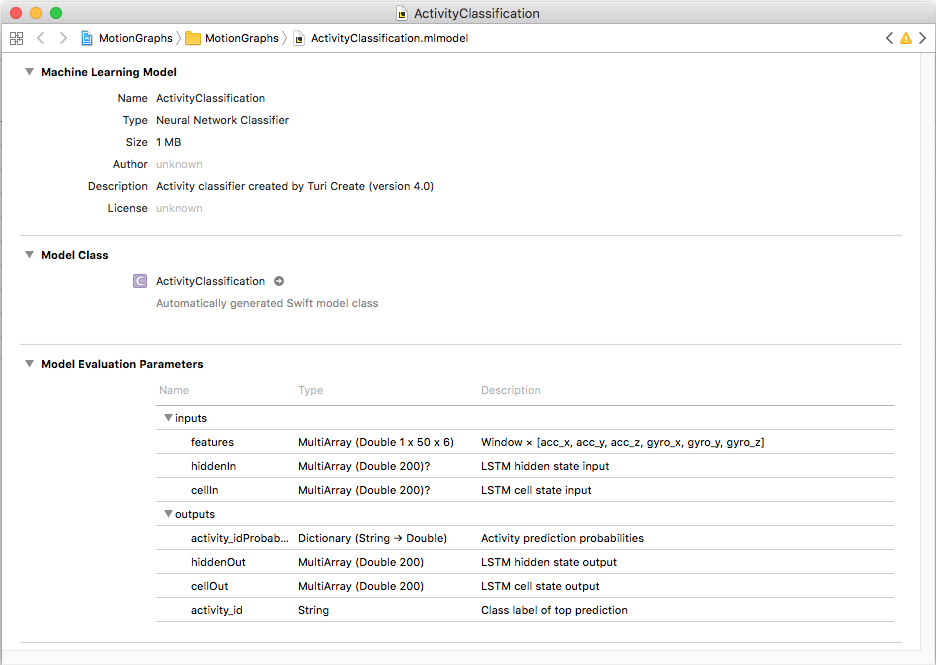Deploying to Core ML
In this section, we describe how to export the model created by the activity_classifier toolkit to Core ML, and use it in Xcode to get real time predictions in a swift app.
Exporting an activity classifier model in Core ML format can be performed using the export_coreml function.
model.export_coreml('ActivityClassification.mlmodel')Dragging the saved model to Xcode will automatically generate relevant code for calling the model in your app:

For more information about the generated programmatic API please refer to Core ML documentation.
Model Inputs
- features - an array in the length of
prediction_windowand width equal to the number of features. The array should contain the sensors' readings, that have been aggregated for the pastprediction_windowsamples. - hiddenIn - state input for the model's LSTM recurrent layer. Initialize to zero when starting a new session, otherwise should be fed with the last
hiddenOutoutput of the previous prediction. - cellIn - cell state input for the model's LSTM recurrent layer. Initialize to zero when starting a new session, otherwise should be fed with the last
cellOutoutput of the previous prediction.
Model Outputs
- activity_idProbability - a dictionary, where the keys are each possible label (predicted activity) and the values are the activity's predicted probability - a double in the range [0.0, 1.0].
- activity_id - a string representing the predicted activity. This is the activity with the highest probability value in
activity_idProbability. - hiddenOut - state output of the model's LSTM recurrent layer. This output should be saved and fed to the model's
hiddenIninput at the next prediction call. - cellOut - cell state output of the model's LSTM recurrent layer. This output should be saved and fed to the model's
cellIninput at the next prediction call.
For more information on the model architecture, please see the how does it work? section.
Applying the Core ML model in an app
Deploying an activity classification model in an iOS/watchOS app involves 3 basic steps:
- Enabling the relevant sensors, and setting them to provide readings at the desired frequency.
- Aggregating the readings from the sensors into a
prediction_windowlong array. - When the array gets full - calling the model's
prediction()method to get a predicted activity.
Creating arrays for aggregating inputs
The ActivityClassifier model expects to receive an array containing prediction_window readings of the sensors' values.
The app will need to aggregate the sensors' readings into a MLMultiArray with dimensions 1 x prediction_window x number_of_features.
In addition - the app needs to save the last hiddenOut and cellOut outputs, to be fed to the model in the next prediction.
struct ModelConstants {
static let numOfFeatures = 6
static let predictionWindowSize = 50
static let sensorsUpdateInterval = 1.0 / 50.0
static let hiddenInLength = 200
static let hiddenCellInLength = 200
}
let activityClassificationModel = ActivityClassification()
var currentIndexInPredictionWindow = 0
let predictionWindowDataArray = try? MLMultiArray(shape: [1 , ModelConstants.predictionWindowSize , ModelConstants.numOfFeatures] as [NSNumber], dataType: MLMultiArrayDataType.double)
var lastHiddenOutput = try? MLMultiArray(shape:[ModelConstants.hiddenInLength as NSNumber], dataType: MLMultiArrayDataType.double)
var lastHiddenCellOutput = try? MLMultiArray(shape:[ModelConstants.hiddenCellInLength as NSNumber], dataType: MLMultiArrayDataType.double)Enabling CoreMotion sensors
We need to enable the accelerometer and gyroscope sensors, set them to the required update interval and set our handler block.
For more info on using CoreMotion sensors please see CoreMotion documentation
guard let motionManager = motionManager, motionManager.isAccelerometerAvailable && motionManager.isGyroAvailable else { return }
motionManager.accelerometerUpdateInterval = TimeInterval(ModelConstants.sensorsUpdateInterval)
motionManager.gyroUpdateInterval = TimeInterval(ModelConstants.sensorsUpdateInterval)
motionManager.startAccelerometerUpdates(to: .main) { accelerometerData, error in
guard let accelerometerData = accelerometerData else { return }
// Add the current data sample to the data array
self.addAccelSampleToDataArray(accelSample: accelerometerData)
}For simplicity - we only show here setting the accelerometer’s block handler.
Aggregating sensor readings
Whenever a new reading has been received from the sensor - we will add it to our prediction_window long data array.
When the array is full - the application is ready to call the model and get a new activity prediction.
func addAccelSampleToDataArray (accelSample: CMAccelerometerData) {
// Add the current accelerometer reading to the data array
guard let dataArray = predictionWindowDataArray else { return }
dataArray[[0 , currentIndexInPredictionWindow ,0] as [NSNumber]] = accelSample.acceleration.x as NSNumber
dataArray[[0 , currentIndexInPredictionWindow ,1] as [NSNumber]] = accelSample.acceleration.y as NSNumber
dataArray[[0 , currentIndexInPredictionWindow ,2] as [NSNumber]] = accelSample.acceleration.z as NSNumber
// Update the index in the prediction window data array
currentIndexInPredictionWindow += 1
// If the data array is full, call the prediction method to get a new model prediction.
// We assume here for simplicity that the Gyro data was added to the data array as well.
if (currentIndexInPredictionWindow == ModelConstants.predictionWindowSize) {
let predictedActivity = performModelPrediction() ?? "N/A"
// Use the predicted activity here
// ...
// Start a new prediction window
currentIndexInPredictionWindow = 0
}
}Making predictions
After prediction_window readings were aggregated, we call the model to get a prediction of the current user's activity.
func performModelPrediction () -> String? {
guard let dataArray = predictionWindowDataArray else { return "Error!"}
// Perform model prediction
let modelPrediction = try? activityClassificationModel.prediction(features: dataArray, hiddenIn: lastHiddenOutput, cellIn: lastHiddenCellOutput)
// Update the state vectors
lastHiddenOutput = modelPrediction?.hiddenOut
lastHiddenCellOutput = modelPrediction?.cellOut
// Return the predicted activity - the activity with the highest probability
return modelPrediction?.activity_id
}